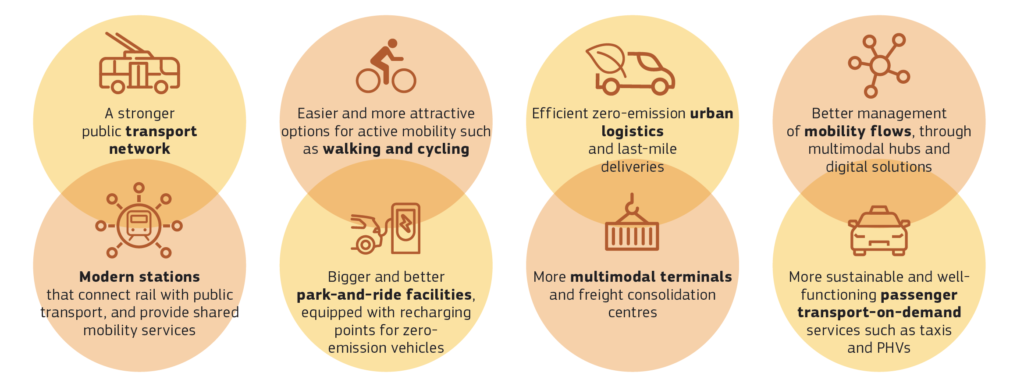To support the transition to cleaner, greener, and smarter mobility, in line with the objectives of the European Green Deal, the European Commission adopted four proposals that will modernize the EU’s transport system. By increasing connectivity and shifting more passengers and freight to rail and inland waterways, by supporting the roll-out of charging points, alternative refueling infrastructure, and new digital technologies, by placing a stronger focus on sustainable urban mobility, and by making it easier to choose different transport options in an efficient multimodal transport system, the proposals will put the transport sector on track to cutting its emissions by 90%. In addition, the EU will set a common European framework with measures including guidance on how to address air pollution, congestion, accessibility, urban road safety, growth of e-commerce, and other urban mobility challenges.
TEN-T
The TEN-T is an EU-wide network of rail roads, inland waterways, short-sea shipping routes, and roads. It connects 424 major cities with ports, airports, and railway terminals. The revised TEN-T Regulation proposes strengthening the role of cities on the Trans-European Transport (TEN-T) Network as vital enablers of sustainable, efficient, and multimodal transport.
To address the missing links and modernize the entire network, the new proposal:
- Requires that the major TEN-T passenger rail lines allow trains to travel at 160 km/h or faster by 2040 thus creating competitive high-speed railway connections throughout the Union. Canals and rivers must ensure good navigation conditions, unhindered for example by water levels, for a minimum number of days per year.
- Calls for more transhipment terminals, improved handling capacity at freight terminals, reduced waiting times at rail border crossings, longer trains to shift more freight onto cleaner transport modes, and the option for lorries to be transported by train network-wide. To ensure infrastructure planning meets real operational needs, it also creates nine ‘European Transport Corridors’ that integrate rail, road, and waterways.
- Introduces a new intermediary deadline of 2040 to advance the completion of major parts of the network ahead of the 2050 deadline that applies to the wider, comprehensive network. So new high-speed rail connections between Porto and Vigo, and Budapest and Bucharest – among others – must be completed for 2040.
- Requires all 424 major cities along the TEN-T network to develop Sustainable Urban Mobility Plans to promote zero-emission mobility and to increase and improve public transport and infrastructure for walking and cycling.
Sustainable city logistics
Action points cover making city logistics resilient, environmentally friendly, and energy-efficient and identifying zero-emission solutions for urban logistics. Obligations will achieve this by putting in place recharging and refueling infrastructure for electric and hydrogen vehicles in cities and improved coordination and dedicated funding for cities under the Climate-neutral and Smart Cities mission.
More effective zero-emission city freight logistics and last-mile deliveries thanks to integrating sustainable urban logistics plans (SULPs) within the SUMP framework and voluntary data sharing between all stakeholders. Cities also need to have multimodal freight terminals to ensure sustainable urban logistics.

Smart mobility
Smart mobility makes mobility more sustainable. Therefore, the Commission is proposing to update the 2010 ITS Directive, adapting to the emergence of new road mobility options, mobility apps, and connected and automated mobility. The proposal will stimulate the faster deployment of new, intelligent services by proposing that particular crucial road, travel, and traffic data be made available in digital formats, such as speed limits, traffic circulation plans, or roadworks, along the TEN-T and ultimately covering the entire road network. It will also ensure that essential safety-related services are made available for drivers along the TEN-T network.
